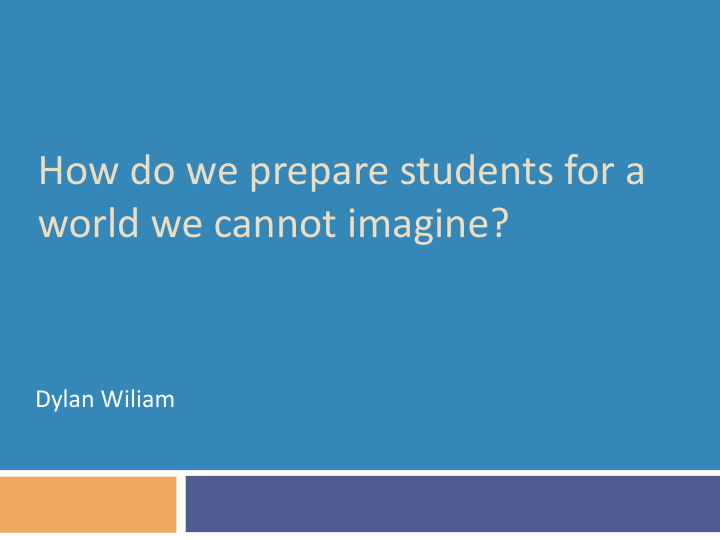



How do we prepare students for a world we cannot imagine? Dylan Wiliam
Three long-term trends 2 Changes in: The world of work The abilities of children The quality of teachers How we should respond �
Non-economic benefits of education 3 More educated students live longer are healthier have less disability towards the end of their lives are more tolerant are less likely to be teenage parents are less likely to be incarcerated are less likely to commit suicide Centre for Research on the Wider Benefits of Education (www.learningbenefits.net) �
Raising achievement matters for society too 4 Increased economic growth: Net present value to the U.S. of a 25-point increase on PISA: $40 trillion (U.S. national debt: $13 trillion) Net present value to the U.S. of getting all students to 400 on PISA: $70 trillion �
Changes in skills needed in the workplace Skill category Percentage change 1969- 1999 Complex communication +14% Expert thinking/problem solving +8% Routine manual – 3% Non-routine manual – 5% Routine cognitive – 8% Autor, Levy & Murnane (2003) �
Real-terms changes in salary: 1978 to 2005 Education level Change in salary Postgraduate qualification +28% BA/BSc +19% Some college 0% High school diploma 0% High school dropout -16% Economic Policy Institute (2010) �
Off-shoring and automation 7 Off-shoreable Not off-shoreable Radiographer Surgeon (?) Skilled Security analyst Bricklayer Tax accountant Hairdresser Food packager Grocery store clerk Unskilled Data entry clerk Receptionist Call centre operator Retail salesperson �
How flat is the world? 8 Percentage crossing national boundaries Physical mail: Telephone minutes: Internet traffic: First generation immigrants: University students: People, ever in their lives: Goods and services: Ghemawat (2011) �
Mostly round; some flat bits 9 Percentage crossing national boundaries Physical mail: 1 Telephone minutes: 2 Internet traffic: 17 First generation immigrants: 3 University students: 2 People, ever in their lives: 10 Goods and services: 10 Ghemawat (2011) �
There is only one 21st century skill 10 So the model that says learn while you ’ re at school, while you ’ re young, the skills that you will apply during your lifetime is no longer tenable. The skills that you can learn when you ’ re at school will not be applicable. They will be obsolete by the time you get into the workplace and need them, except for one skill. The one really competitive skill is the skill of being able to learn. It is the skill of being able not to give the right answer to questions about what you were taught in school, but to make the right response to situations that are outside the scope of what you were taught in school. We need to produce people who know how to act when they ’ re faced with situations for which they were not specifically prepared. (Papert, 1998) �
In place of achievement gaps 11 An alternative aspiration: All students proficient Many students excellent All sub-groups of students properly represented in the excellent �
What kinds of schools do we need? School model Ethos Key process Talent refineries School must provide Ensuring good teaching and opportunities for students syllabus coverage to show what they can do Talent All students students can Drawing out what is within incubators learn, but not all students the student can achieve at high levels Talent factories All students can achieve at Whatever it takes high levels �
Where’s the solution? 13 School organization School structure Curriculum reform Technology Workforce reforms �
We need to focus on classrooms, not schools 14 In the USA, variability at the classroom level is at least four times that at school level. As long as you go to school, it doesn’t matter very much which school you go to. But it matters very much which classrooms you are in. It’s not class size. It’s not the between -class grouping strategy. It’s not the within -class grouping strategy. �
And most of all on teachers 15 Take a group of 50 teachers: Students taught by the most effective teacher in that group of 50 teachers learn in six months what those taught by the average teacher learn in a year. Students taught by the least effective teacher in that group of 50 teachers will take two years to achieve the same learning (Hanushek & Rivkin, 2006) And furthermore: In the classrooms of the most effective teachers, students from disadvantaged backgrounds learn at the same rate as those from advantaged backgrounds (Hamre & Pianta, 2005).
The value of teachers 16 According to Chetty et al. (2011) being taught by a good teacher for just one year increases lifetime earnings by $50,000 (NPV: $9,000) A good teacher contributes around $450,000 to the US economy every single year (Hanushek, 2011) �
Replace existing teachers with better ones? 17 De-select (i.e., fire) ineffective teachers? Replace least effective 10% with average teachers 2 points on PISA (right away, if it can be done) Raising the bar for entry into the profession? Require teachers to have masters degrees 0 points on PISA (ever) Exclude the lowest performing 30% from getting in 5 points on PISA (in 30 years time) So we have to help the teachers we have improve The “love the one you’re with” strategy �
How do we speed up teacher improvement? 18 Merit pay for effective teachers? Can’t be done fairly, and doesn’t work Create a culture of continuous improvement Responsibilities of teachers To continue to improve classroom skill for the whole career To focus the improvement on ideas supported by evidence Responsibilities of leaders Create the expectation for continuous improvement Keep the focus on what is likely to improve achievement Provide support Encourage risk taking �
Approaches to formative assessment 19 Improve team-work and systems Professional learning communities Regular meetings focused on data 16 points on PISA (in two to three years) Improve classroom practice Teacher learning communities Investing in high-quality PD for teachers 30 points on PISA (in two to three years) �
Recommend
More recommend